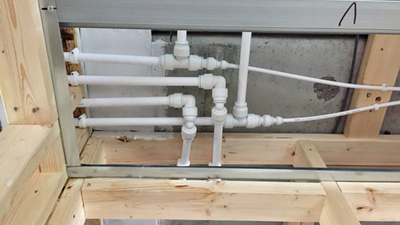The future is plastic push-fit plumbing: How to save time and money during installation

Installers are traditionally loyal to the plumbing materials they’ve been brought up with. This is especially true of those who have been using copper pipes for years and are wary about the reliability of plastic push-fits.
But if we told you that you could save up to 40% on installation times, wouldn’t you consider the switch to plastic push-fits?
With 40% more time, you could move onto the next job quicker. Being quicker on jobs also improves your reputation, as speed and efficiency drives the modern day market.
Ultimately, the technology behind plastic push-fit plumbing makes it a non-contest between copper.
Copper – A thing of the Past
Copper has been around for many years, but in those years, the technology behind it hasn’t changed much. It still comes with complex and time-consuming stages of soldering joints together.
On the other hand, since plastic’s arrival, it has gone from strength to strength. Plastic push-fit fittings and pipe come in standard UK pipe sizes, and allow connections to be made in a matter of seconds. Pipes are specially engineered too like the ultra-flexible JG Layflat ® polybutylene pipe, which can help you deliver efficiency in a number of ways.
Firstly, the Layflat® pipe is available in a variety of sizes and coil lengths making it adaptable for any type of plumbing or heating project. As they are flexible, the coils take up less space in an installer’s van and are much easier to carry on site, unlike rigid copper pipes. The flexibility of polybutylene also means installers can thread it through joists with minimal effort.
As the JG Layflat® range is supplied in coils up to 50m in length, this also reduces the need for making multiple connections between pipes, which are common areas for leakage to occur. On the other hand, copper pipes rely on soldered connections, and when laid in or through wooden joists or under floorboards, finding the leak is commonly an exhaustive and disruptive task.

The technology behind plastic pipes
Polybutylene pipes have an array of performance advantages. A key benefit is its lower thermal diffusivity compared to copper pipes. This means water in the pipe is less likely to freeze and burst the pipe during extreme cold temperatures. However, even if freezing does happen, the pipe expands and can potentially take account of the some added volume, returning to normal dimensions when the ice thaws. This thermal characteristic operates conversely, making them cooler to the touch, even when hot water is running through. Contrarily, exposed copper pipes can cause burns if touched accidentally.
Layflat® pipes are also easier to handle. As the name says, when they are taken out of the coil, the pipe keeps straight and “lays flat”. The pipe is designed to have low memory retention so it doesn’t coil back into its shape. The pipe is also made of five layers, the centre of which is a coloured oxygen barrier. This prevents the ingress of air into the plumbing and heating system, therefore reducing the effect of corrosion on metal components.
Once you go plastic, you never go back
Plastic push-fit fittings are engineered to very high standards and go through very rigorous testing, passing the necessary BSI and WRAS standards. The unique collet that grips the pipe and the additional twist and lock® mechanism delivery a leak-tight connection. When a push-fit connection is made, it is right first time, every time.
Plastic is also much easier to work with. There is no need for blowtorches, solder and cleaning agents like flux. Consequently, there is less risk of fire hazards, and also to the installer’s health through breathing in poisonous fumes and possibility of serious skin burns.
It has been proven that plastic can cut down the installation time of the same job by over a third, and difficult tasks like working in tight awkward spaces are made a lot easier.

Switching to plastic push-fit solutions not only helps you with your job, but in the long run it can boost your reputation, secure more jobs and customers, and help you stay safe. Make the switch now – you’ll never go back once you have.
Innovation in our DNA
Great engineering is about invention, design and the manufacture of practical solutions to complex problems.

